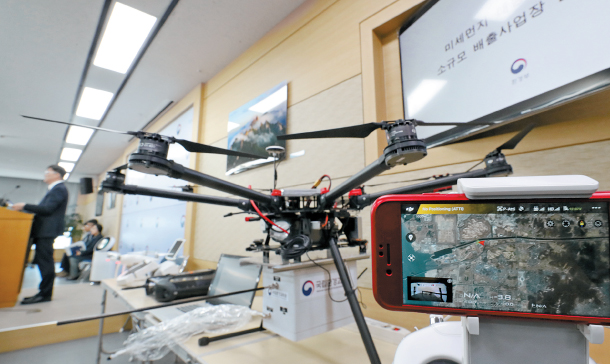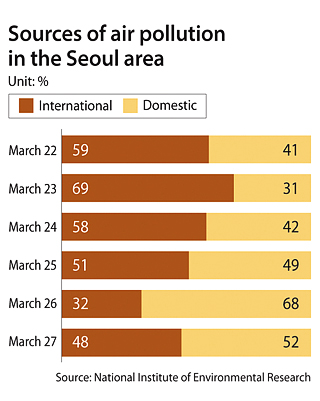Government deploys drones to fight dust

Shin Geon-il, head of the Air Quality Management Division at the Ministry of Environment, announces the ministry’s plan to use drones to detect illegal emissions at factories in the Seoul area during a news conference at the ministry’s headquarters in Sejong on Tuesday. [YONHAP]
The ministry plans to use drones mounted with cameras to capture videos of potentially illegal incineration and emissions at factories in the Seoul area. Vehicles and drones equipped with air quality monitoring devices will patrol the areas for pollutants.
“We used to have employees on the ground trying to detect illegal practices at these factories,” said Shin Geon-il, head of the ministry’s Air Quality Management Division. “They would spend long hours investigating without bearing much fruit. With the use of drones, we can find evidence of illegal emissions and dispatch employees immediately to these locations.”
The ministry tested the use of drone cameras on March 28 when it was investigating two factories in Gwangju, Gyeonggi, for illegal incineration and two other plants for emitting too many pollutants. The ministry plans to file a request to the Gwangju city government to temporarily shut down the factories until they can meet emission requirements.
As of 2016, Korea is home to 57,500 factories emitting air pollutants, and about 90 percent of them are small plants that emit less than 10 tons a year, according to the ministry. The drones will focus on those small factories in the outskirts of Seoul.
“We will come up with a guideline on how to use these drones and vehicles mounted with air quality monitoring devices,” said Kim Jong-ryul, head of the Air Quality Policy Bureau at the ministry, “and hope to apply such a system throughout the country to manage emissions at all factories and plants.”
Air pollution levels rose again on Wednesday after hitting a three-year peak in the last week of March. At 9 a.m., the amount of PM2.5 particles in Seoul was 39 micrograms per cubic meter of air, according to Air Korea, a service run by the Korea Environment Corporation, which is affiliated with the Environment Ministry.
PM2.5 particles are less than 2.5 micrometers in diameter, about 30 times smaller than the width of a human hair, and can travel through the respiratory tract into the bloodstream. The World Health Organization described fine dust particles as carcinogenic in 2013 and recommends exposure of no more than a daily average of 25 micrograms.

“Yellow dust from the Gobi Desert and Inner Mongolia flew over the Korean Peninsula from Tuesday night,” said an official of the administration Wednesday. “Due to this, the western coastal region and central part of the country will experience higher levels of fine dust than usual.”
Yellow dust is known to carry more PM10 than PM2.5 particles, according to the Seoul Metropolitan Government’s Climate and Environment Headquarters. PM10 particles are larger than PM2.5 particles but are also carcinogenic. The WHO recommends exposure of no more than a daily average of 50 micrograms of PM10.
At 9 a.m., Air Korea detected 101 micrograms of PM10 in Seoul, 110 micrograms in Gyeonggi and Gangwon, 101 micrograms in South Chungcheong, 106 micrograms in Sejong and 123 micrograms in North Chungcheong.
The Korea Meteorological Administration forecasted that the air pollution was expected to clear later in the day on Wednesday.
Korea receives yellow dust from the Gobi Desert every spring, but the pollution has become especially severe in recent years. The country was ranked second worst in terms of air quality among developed countries in the OECD in February 2017.
A joint study conducted by the United States’ NASA and Korea’s National Institute of Environmental Research (NIER) from May to June 2016 found that about 34 percent of fine dust pollution in Korea that summer came from China.
A more recent study released by NIER and another Korean institute on Monday said nearly 70 percent of the air pollution that blanketed Korea in the final week of March came from China and other countries and that conditions worsened as the particles mixed with domestic pollutants.
On March 25, the average level of PM2.5 fine dust reached 99 micrograms per cubic meter of air in Seoul and 102 micrograms in Gyeonggi, the worst levels that the two areas have experienced since 2015.
According to NIER and the Seoul Research Institute of Public Health and Environment, 58 to 69 percent of the air pollutants in the country from March 22 to 24 originated from China and other countries.
However, the proportion of international pollutants decreased afterward, making up 32 to 51 percent of pollutants between March 25 and 27 as they mixed with domestically produced particles.
“On March 25, when fine dust levels hit their highest point in the week, international air pollutants took up 51 to 70 percent of total air pollutants in the morning, while in the afternoon, the level of domestic air pollutants took up 59 to 82 percent of all air pollutants,” the Ministry of Environment said in a press release Monday. “The National Institute of Environmental Research concluded that after the fine dust entered the country from abroad from March 22 to 24, they mixed with domestic pollutants from March 25 to 26, exacerbating air conditions.”
The ministry added that stagnant air and high humidity from March 25 to 26 also contributed to exceptionally bad air pollution. “The last time there was an extended period of severe air pollution was from Jan. 15 to 18, and at that time, the National Institute of Environmental Research deduced that the air pollution was largely based on domestic factors,” the ministry said. “But from March 22 to 27, the institute said air pollution was the result of a mix of air pollutants from abroad and within the country.”
BY ESTHER CHUNG, CHON KWON-PIL AND KANG CHAN-SU [chung.juhee@joongang.co.kr]










with the Korea JoongAng Daily
To write comments, please log in to one of the accounts.
Standards Board Policy (0/250자)